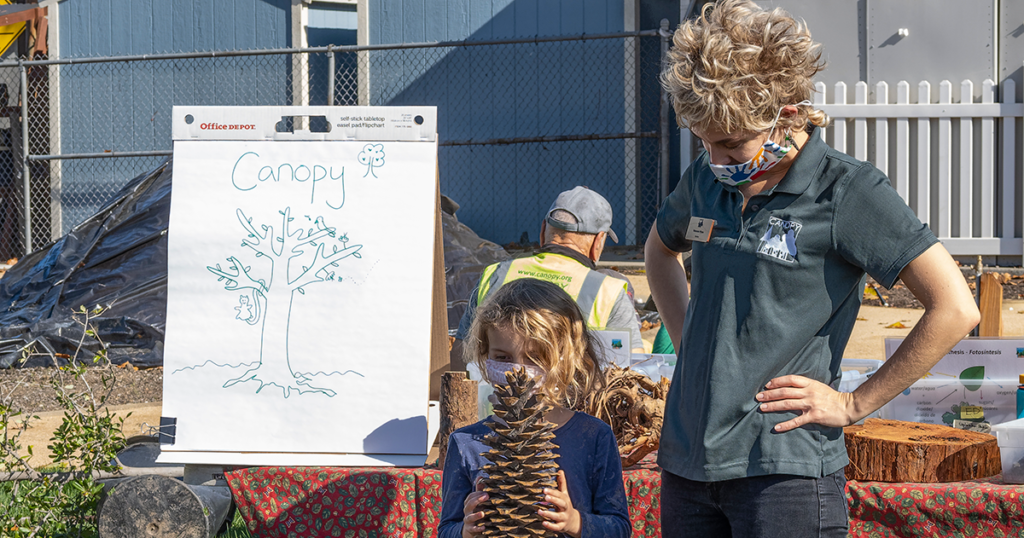- About Us
- Our Work
- Tree Info
- Get Involved
- Blog
- Volunteer
- Support Us
By Yingran Zhang on April 29, 2022

Education Director Vanessa Wyns leads an outdoor lesson on trees at an All Five preschool planting event.
May is Mental Health Awareness month. Nowadays, millions of Americans are living with mental health issues, especially people who live in cities. As Canopy has mentioned in this previous blog, being around trees helps to decrease loneliness, reduce psychological stress, boost immune system function, and increase job/academic performance. To raise people’s awareness of urban forests, planting and learning about trees through outdoor education programs would be a good place to start. However, these outdoor education programs are hit hard by the Covid-19 pandemic.
The Lawrence Hall of Science at the University of California, Berkeley released a report focusing on the impact of the Covid-19 pandemic on outdoor science education programs. The report stated that, in 2020, millions of students missed outdoor learning opportunities, about 30,000 program staff and faculty lost their jobs, and outdoor program’s related industries lost $600 million of revenue, ⅔ of them even ended up shut down (Dorph etal., 2022). Many program leaders worry the program will not be able to keep up the quality after the pandemic due to budget. This leads to a larger educational gap between low-income and high-income communities, and fewer BIPOC (black, indigenous, people of color) workers remain in the programs.

It is necessary for students to receive outdoor education. The article “The importance of going outside for youth education” from Pacific Oaks College points out its several benefits. Outdoor learning allows students the ability to apply concepts learned inside the classroom to the real world; students get to explore, examine, then elaborate on their discoveries on concepts learned in class. As the article has mentioned, “Nature is necessary for a child’s well-being—it nurtures their imagination, uplifts the senses, and promotes happiness and productivity”(Voice, 2021). When it comes to environmental education, students not only get to explore but also get physical activity, sunlight, fresh air, and time away from screens. In the process of outdoor learning, students are not only able to learn and explore but also develop a close relationship with nature, knowing the importance of nature’s contribution and value to our life. This is also what Canopy’s Education Programs advocate for.
Outdoor education could be a “high point of school time” for many students. For students from low-income or BIPOC communities, participating in these outdoor programs might be their only experience in outdoor environmental education. Canopy’s belief that every child deserves to enjoy the benefits of nature is what led us to offer our education services primarily to schools with students with high needs. With the help of generous donors and institutional funders, Canopy is able to offer free educational programs to students from these communities.
In the newsletter “Lingering Concerns & Signs of Hope for Nation’s Outdoor Science Programs”, Rena Dorph concluded, “Youth are suffering deeply from the learning consequences and mental health challenges of this pandemic. It is critical that policymakers and funders at every level invest in building a strong and lasting infrastructure, so we forge a path towards a new normal that prioritizes outdoor learning experiences in ways that advance equity and environmental justice”.

Despite the negative effects felt during the pandemic, the outdoor education programs are still working hard to maintain capacity. To survive through the next couple of years, funding for program capacity and building is needed. According to the report, 71% of the programs reopened with modified capacity, and 12% reopened with full capacity in 2021. Most programs have decided to spend their budget primarily on communities with people of color and low-income residents; however, leadership at environmental nonprofits tend to be primarily white (diversigreen.org, 2014). With the goal of increasing diversity, more than 50% of organizations promised to increase equity and inclusion initiatives. More than 70% of the programs believe they will definitely return to normal in 5 years.
“It has been a joy to return to in-person programs this spring and see their value firsthand, as the students discover, explore, and investigate trees,” says Vanessa Wyns, Canopy’s education director. “A lot of the rhetoric during the pandemic has stated that things of great value such as community, family, nature, and mental health support are now ‘more important than ever.’ In reality, these things are no more important than they have always been. They have always been incredibly important. It’s simply that more people are beginning to recognize, or perhaps remember, their value. It is my hope that through our work at Canopy, offering fun and informative outdoor lessons, nature play, and opportunities to plant trees in communities, we can raise kids and young adults who grow to love nature and never forget the great value that it adds to all of our lives.”
As we can see, outdoor programs are doing all they can to serve the students. The future for outdoor education is still bright.
Yingran Zhang is a 2022 Spring communications intern at Canopy and a B.A. English Professional Writing and Rhetoric student at San Francisco State University. She would like to become a technical writer who works with different media forms. In her free time, she likes to have a walk in nature, listen to music, and watch anime.